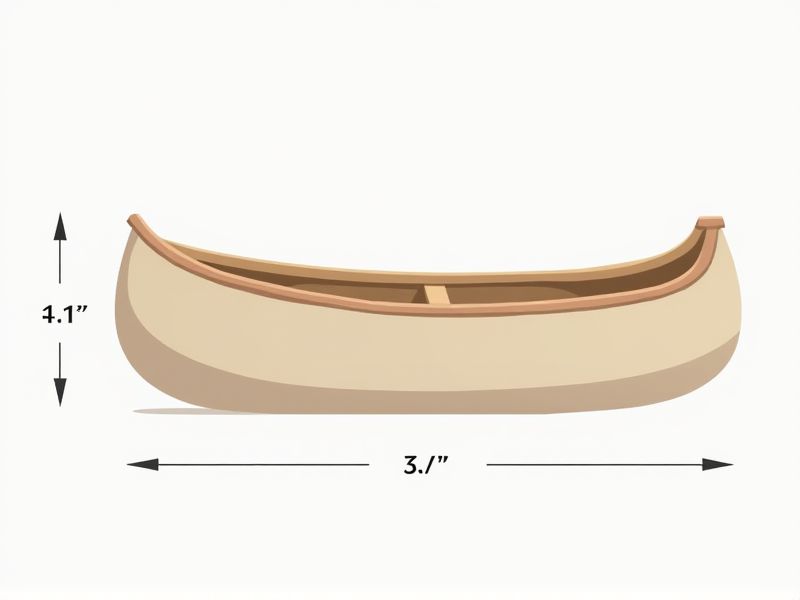
Standard canoes typically range from 13 to 17 feet (4 to 5.2 meters) in length, with the most common recreational models being around 16 feet long. The average width, or beam, is usually between 33 to 36 inches (84 to 91 centimeters), providing stability while still allowing for efficient paddling. Depths can vary, but a midship depth of 13 to 15 inches (33 to 38 centimeters) is standard to keep water out while accommodating gear and paddlers. These dimensions can shift depending on the intended use; for example, shorter canoes are easier to maneuver, while longer ones track straighter and can carry more weight.
Length
The standard length of a canoe typically ranges from 14 to 18 feet, with most recreational models falling between 16 and 17 feet. Longer canoes, around 18 feet, provide greater straight-line tracking and increased storage capacity, making them ideal for extended trips. Conversely, shorter canoes, around 14 to 15 feet, offer enhanced maneuverability, perfect for navigating tight waterways or rivers. When selecting your canoe, consider how the length will affect your paddling experience, stability, and the type of water you intend to explore.
Width
The standard width of a recreational canoe typically ranges from 32 to 36 inches, providing stability for beginners and ease of maneuverability on calm waters. In contrast, racing canoes generally feature a narrower design, often measuring between 28 to 30 inches, optimizing speed and reducing water resistance. A wider canoe offers enhanced stability, accommodating larger groups and gear, making it ideal for family outings or fishing trips. Your choice in width will greatly affect handling, stability, and performance in various water conditions.
Depth
The depth of a canoe can significantly influence its stability and speed on the water. Standard canoes typically range from 12 to 18 feet in length, with a depth between 12 to 15 inches. A deeper canoe often provides better tracking and resistance to wind, making it suitable for open water paddling. If you prioritize depth, consider how it affects both cargo capacity and overall maneuverability for your specific paddling needs.
Bow Height
The standard bow height for canoes typically ranges between 18 to 24 inches, which helps improve stability and maneuverability in various water conditions. A higher bow reduces the risk of water splashing into the canoe, enhancing your overall paddling experience. When selecting a canoe, keep in mind that the bow height can significantly impact performance, especially in choppy waters or when traversing rapids. Choosing a canoe with the appropriate bow height for your intended use will ensure better tracking and ease of navigation.
Stern Height
The stern height of a canoe significantly impacts its stability and maneuverability, with commonly recommended measurements ranging between 15 to 20 inches. A higher stern can enhance tracking and reduce drag, allowing you to glide smoothly through the water. For recreational paddlers, a stern height of around 16 inches often provides a balance between performance and comfort. If you prioritize swift navigation in varying water conditions, consider models featuring adjustable stern heights up to 20 inches for optimal control.
Load Capacity
Canoes typically possess a load capacity ranging from 350 to 700 pounds, depending on their design and materials. This capacity includes both the weight of passengers and any gear you may carry, ensuring stability and performance in the water. For optimal performance, it's essential to choose a canoe that meets your specific needs, factoring in the number of people and equipment. Lightweight models made from materials like fiberglass or aluminum often provide a higher load capacity without sacrificing maneuverability.
Rocker
The rocker of a canoe, measured from bow to stern, significantly influences maneuverability and stability. A moderate rocker, typically ranging from 1 to 3 inches, allows for a balance between tracking straight and turning easily, making it ideal for recreational paddlers. High rocker designs, exceeding 3 inches, enhance agility, perfect for navigating tight rivers or quick turns, while flat-bottom canoes, with negligible rocker, prioritize speed and tracking in calm waters. Understanding these specifications helps you select a canoe that aligns with your paddling style and intended water conditions.
Tumblehome
The Tumblehome design feature in canoes significantly impacts stability and maneuverability, characterized by the inward curvature of the hull near the top. This design allows for easier paddling in tight spaces and enhances lateral stability, which is crucial for navigating turbulent waters. Standard canoe widths range from 30 to 33 inches, with a well-designed tumblehome facilitating a narrower top while maintaining a wider base for stability. Choosing a canoe with an optimized tumblehome can enhance your paddling experience by providing a balance between speed and control.
Draft
The standard draft for a recreational canoe typically ranges from 4 to 6 inches, allowing for optimal stability and maneuverability in various water conditions. This shallow draft minimizes the risk of grounding in shallow areas, making it suitable for lakes and slow-moving rivers. When selecting a canoe, consider that a deeper draft, around 8 to 10 inches, provides greater stability in rougher waters, but may limit your access to shallower regions. Your choice of draft can significantly influence your canoeing experience, affecting both how you navigate and the types of waterways you can explore.
Hull Shape
The hull shape of a canoe significantly impacts its performance, stability, and efficiency on water. Canoes with a flat hull are ideal for calm waters, providing excellent stability, while V-shaped hulls enhance tracking and speed in moving water. The depth and width of the hull also play crucial roles; for instance, a wider hull offers better stability, making it suitable for beginners, while narrower designs tend to be faster for experienced paddlers. Understanding these hull characteristics can help you choose the right canoe for your specific needs, whether for recreation or sport.
